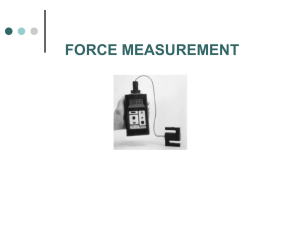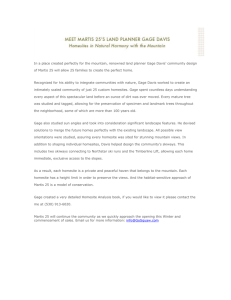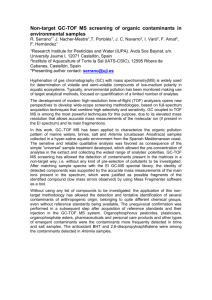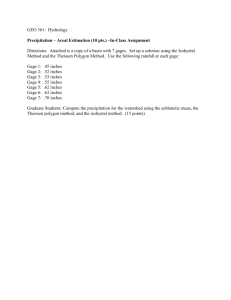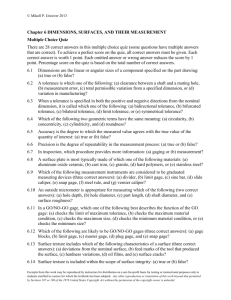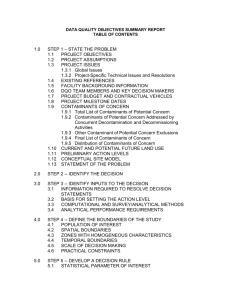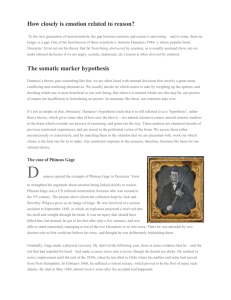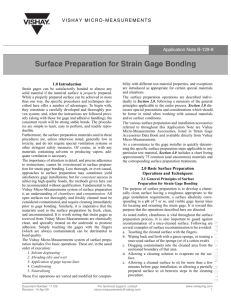11166 Cleaning Surfaces
advertisement
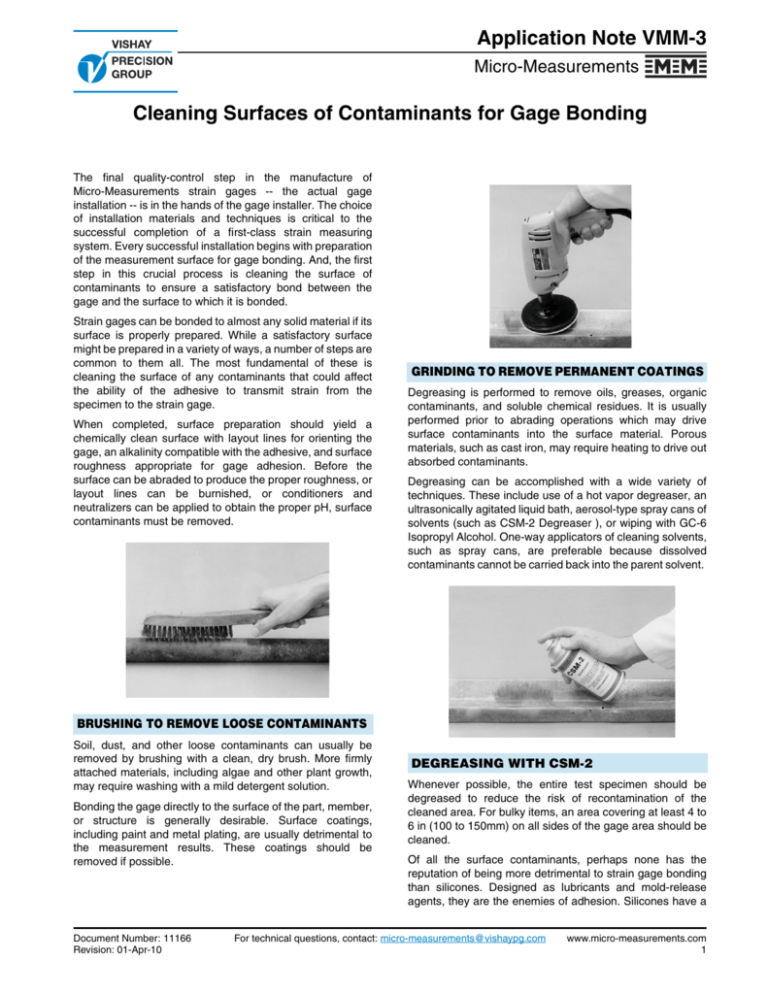
Application Note VMM-3 Micro-Measurements Cleaning Surfaces of Contaminants for Gage Bonding The final quality-control step in the manufacture of Micro-Measurements strain gages -- the actual gage installation -- is in the hands of the gage installer. The choice of installation materials and techniques is critical to the successful completion of a first-class strain measuring system. Every successful installation begins with preparation of the measurement surface for gage bonding. And, the first step in this crucial process is cleaning the surface of contaminants to ensure a satisfactory bond between the gage and the surface to which it is bonded. Strain gages can be bonded to almost any solid material if its surface is properly prepared. While a satisfactory surface might be prepared in a variety of ways, a number of steps are common to them all. The most fundamental of these is cleaning the surface of any contaminants that could affect the ability of the adhesive to transmit strain from the specimen to the strain gage. When completed, surface preparation should yield a chemically clean surface with layout lines for orienting the gage, an alkalinity compatible with the adhesive, and surface roughness appropriate for gage adhesion. Before the surface can be abraded to produce the proper roughness, or layout lines can be burnished, or conditioners and neutralizers can be applied to obtain the proper pH, surface contaminants must be removed. GRINDING TO REMOVE PERMANENT COATINGS Degreasing is performed to remove oils, greases, organic contaminants, and soluble chemical residues. It is usually performed prior to abrading operations which may drive surface contaminants into the surface material. Porous materials, such as cast iron, may require heating to drive out absorbed contaminants. Degreasing can be accomplished with a wide variety of techniques. These include use of a hot vapor degreaser, an ultrasonically agitated liquid bath, aerosol-type spray cans of solvents (such as CSM-2 Degreaser ), or wiping with GC-6 Isopropyl Alcohol. One-way applicators of cleaning solvents, such as spray cans, are preferable because dissolved contaminants cannot be carried back into the parent solvent. BRUSHING TO REMOVE LOOSE CONTAMINANTS Soil, dust, and other loose contaminants can usually be removed by brushing with a clean, dry brush. More firmly attached materials, including algae and other plant growth, may require washing with a mild detergent solution. Bonding the gage directly to the surface of the part, member, or structure is generally desirable. Surface coatings, including paint and metal plating, are usually detrimental to the measurement results. These coatings should be removed if possible. Document Number: 11166 Revision: 01-Apr-10 DEGREASING WITH CSM-2 Whenever possible, the entire test specimen should be degreased to reduce the risk of recontamination of the cleaned area. For bulky items, an area covering at least 4 to 6 in (100 to 150mm) on all sides of the gage area should be cleaned. Of all the surface contaminants, perhaps none has the reputation of being more detrimental to strain gage bonding than silicones. Designed as lubricants and mold-release agents, they are the enemies of adhesion. Silicones have a For technical questions, contact: micro-measurements@vishaypg.com www.micro-measurements.com 1 Application Note VMM-3 Micro-Measurements Cleaning Surfaces of Contaminants for Gage Bonding high natural affinity for most materials, and have a tendency to migrate. Further, they are relatively inert chemically, and are unaffected by most solvents. The best method of dealing with silicone contamination is avoidance. Unfortunately, they are used in a wide variety of products, including hand creams, cosmetics, and cleaning tissues for eyeglasses. Should a light silicone contamination be encountered in the surface area being cleaned, Conditioner A, heated to +200°F (+95°C), may prove effective in removing it. For more severe contaminations, special cleaning solutions and procedures recommended by the manufacturer of the silicone material may be required. The properties of some materials require special cleaning procedures. Concrete is normally cleaned by vigorously scrubbing with a stiff-bristled brush and a mild detergent solution, followed by a rinse with clean water. Loose dust produced by subsequent removal of surface irregularities is removed by blowing or brushing it from the clean surface. When plastics and composites are affected by strong solvents, GC-6 Isopropyl Alcohol may be the only choice for degreasing. Hot-vapor degreasing is essential for specimens made of sintered metals. And, wood is cleaned by simply abrading the surface and dusting it with a clean, dry brush. Details concerning surface preparation for strain gage bonding are provided in Instruction Bulletin B-129, Surface Preparation for Strain Gage Bonding and all Micro-Measurements training programs. Additionally, the staff of our Applications Engineering Department is always available to assist with recommendations concerning your specific application. www.micro-measurements.com 2 For technical questions, contact: micro-measurements@vishaypg.com Document Number: 11166 Revision: 01-Apr-10

